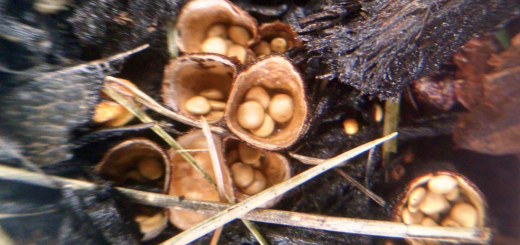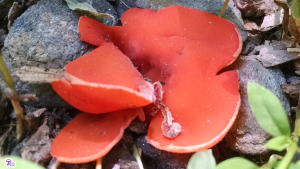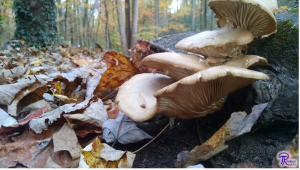#156: Calvatia gigantea, the Giant Puffball
This mushroom certainly lives up to its name! The largest Calvatia gigantea fruiting body on record was 8ft 8in in diameter and weighed 48 pounds! Normally, the “Giant Puffball” forms mushrooms much smaller than that. However, the mushrooms routinely reach sizes of a foot across or larger. Many could easily be mistaken for abandoned soccer balls from far away.
The Giant Puffball is easily recognizable by its large size, roughly circular shape, white color, and smooth exterior. C. gigantea mushrooms are usually 20-60cm (8-24in) in diameter, although they can be much larger. Amazingly, even the largest ones grow to their maximum size in about a week. The exterior of the mushroom is smooth, white, and often marked with wide but shallow irregular pits. As the mushroom ages, it turns yellowish to greenish-brown and the outer surface breaks apart to reveal the powdery brown spores. When young, the interior of the Giant Puffball is white and has a fleshy texture. The interior begins to turn yellowish to greenish-yellow as the spores develop and mature. Unlike many puffballs, C. gigantea does not have a sterile base. Consequently, it does not become pear-shaped at the base. Instead, it is flattish or somewhat pinched in. Sometimes, there is a small thread attaching the puffball to the ground. This cord can easily break, allowing the mushroom to roll around and spread its spores.
C. gigantea is saprobic, appearing on the ground usually in lawns and other grassy areas. You can often find the Giant Puffball growing in fairy rings, where multiple mushrooms fruit in a large circle. The mushrooms appear in the late summer through early fall. C. gigantea is distributed across the globe and can be found in temperate areas of both the northern and southern hemispheres. In North America, it is found east of the Rocky Mountains.
In Western North America, there is a different puffball that forms enormous mushrooms: Calvatia booniana. This mushroom is easy to separate from C. gigantea because C. booniana has a distinctly scaly or warty surface.
If the Giant Puffball is smaller than expected (because it is young or for other reasons), it may be confused with some other puffballs. Other species of Calvatia are easy to separate out because they are usually smaller and often have a large, sterile base. Most other puffballs form a single hole in the center of the fruiting body from which spores are puffed out. Earthballs (a.k.a. false puffballs) can also be look-alikes, but they usually have much thicker skin and quickly turn purplish-brown on the inside.
If you are not careful, Amanita buttons (the egg-shaped stage of development found in some mushrooms) can also be mistaken for puffballs. To avoid this potentially deadly mistake, simply slice every puffball you find in half from top to bottom. The flesh should be solid white in color. Amanita buttons, on the other hand, display the outline of a gilled mushroom at the center.
Like most other true puffballs, the Giant Puffball is edible. However, the puffballs should not be eaten if the tissue inside has started to turn yellow or brown. This means the mushroom is approaching maturity and may taste off or be slightly poisonous. Thanks to its large size, areas that are buggy or tough can easily be cut away. When cleaning the mushroom, do not wash it in water. Thanks to its spongy consistency, the Giant Puffball will quickly become soggy when if you do. People seem to enjoy these mushrooms battered and fried.
See Further:
http://www.mushroomexpert.com/calvatia_gigantea.html
https://blog.mycology.cornell.edu/2006/10/26/giant-puffballs-calvatia-gigantea/
http://botit.botany.wisc.edu/toms_fungi/aug98.html
http://www.rogersmushrooms.com/gallery/DisplayBlock~bid~6239.asp
http://www.kew.org/science-conservation/plants-fungi/calvatia-gigantea-giant-puffball


![#069: Amanita muscaria, Part 1: The Type Mushroom [Archived]](https://www.fungusfactfriday.com/wp-content/themes/hueman/assets/front/img/thumb-medium-empty.png)





![#011: Characteristics of Kingdom Fungi [Archived]](https://www.fungusfactfriday.com/wp-content/themes/hueman/assets/front/img/thumb-small-empty.png)



1 Response
[…] range of sizes, from the tiny (2 to 5cm) Lycoperdon pulcherrimum to the giant (up to 5ft, 50lbs) Calvatia gigantea. The exoperidium can be thin and mostly smooth, as in Bovistella radicata, or consist of large, […]